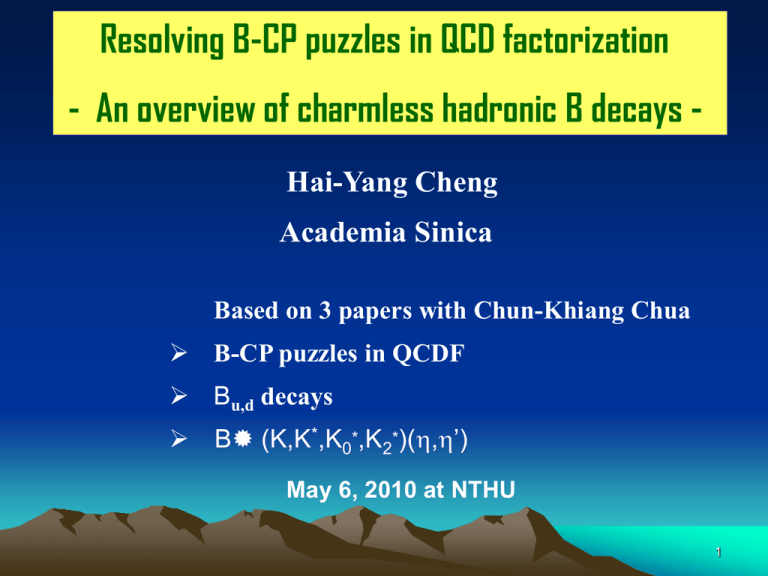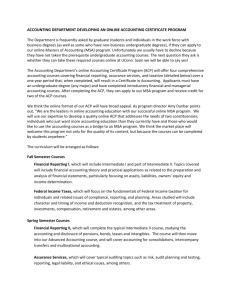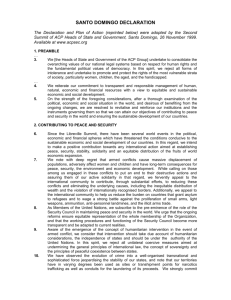Resolving B-CP puzzles in QCD factorization Hai-Yang Cheng Academia Sinica
advertisement

Resolving B-CP puzzles in QCD factorization - An overview of charmless hadronic B decays Hai-Yang Cheng Academia Sinica Based on 3 papers with Chun-Khiang Chua B-CP puzzles in QCDF Bu,d decays B (K,K*,K0*,K2*)(,’) May 6, 2010 at NTHU 1 Day in the life – The Emperor’s Tea : Murayama Direct CP asymmetries K-+ +- ACP(%) -9.8+1.2-1.1 386 S 8.5 6.3 K- K*0 -379 195 AK 14.82.8 5.3 4.1 3.8 K-0 3711 -134 3.4 3.3 AK=ACP(K-0) – ACP(K-+) K*-+ +K- K-0 ACP(%) -187 156 5.02.5 S 2.6 2.5 2.0 - 00 -+ -137 43+25-24 116 1.9 1.8 1.8 CDF: ACP(Bs K+-)=0.390.17 (2.3) 3 In heavy quark limit, decay amplitude is factorizable, expressed in terms of form factors and decay constants. Encounter several difficulties: Rate deficit puzzle: BFs are too small for penguin-dominated PP,VP,VV modes and for tree-dominated decays 00, 00 CP puzzle: CP asymmetries for K-+, K*-+, K-0, +- are wrong in signs Polarization puzzle: fT in penguin-dominated BVV decays is too small 1/mb power corrections ! 4 A(B0 K-+) Theory ua1+c(a4c+ra6c) ACP ( B 0 K - + ) -2 sin Im rFM rFM VubVus* a1 VcbVcs* - ( a4c + rK a6c ) Br 13.1x10-6 ACP 0.04 Expt (19.40.6)x10-6 -0.098+0.012 -0.011 Im4c 0.013 wrong sign for ACP 4c Pc [a4c + r a6c ]SD + [a4c + r a6c ]LD + 3c charming penguin, FSI + ... penguin annihilation 1/mb corrections penguin annihilation 5 1 GF CF 1 1 Aann f B f M1 f M 2 2 s dxdy M1 ( x ) M 2 ( y ) + 2 + ... Nc y ( 1 x y ) x y 2 0 has endpoint divergence: XA and XA2 with XA 10 dy/y 1 dy m X A ln B 1 + Aei A y h 0 Beneke, Buchalla, Neubert, Sachrajda Adjust A and A to fit BRs and ACP A 1.10, A -50o Im(4c+3c) -0.039 6 New CP puzzles K-+ +- AK K- K*0 ACP(%) -9.8+1.2-1.1 386 S 8.5 K-0 14.82.8 -379 195 3711 -134 6.3 5.3 4.1 3.8 3.4 3.3 mb 3.3 PA ( 1.9) K*-+ +K- K-0 ACP(%) -187 156 5.02.5 S 2.6 2.5 2.0 - 00 -+ -137 43+25-24 116 1.9 1.8 1.8 mb PA Penguin annihilation solves CP puzzles for K-+,+-,…, but in the meantime introduces new CP puzzles for K-, K*0, … Also true in SCET with penguin annihilation replaced by charming penguin 7 All “problematic” modes receive contributions from c’=C’+P’EW. AK 0 if c’ is negligible T’ a1, C’ a2, P’EW (-a7+a9), P’cEW (a10+ra8), t’=T+P’cEW AK puzzle is resolved, provided c’/t’ ~ 1.3-1.4 with a large negative phase (naively, |c’/t’| 0.9) a large complex C’ or P’EW Large complex C’: Charng, Li, Mishima; Kim, Oh, Yu; Gronau, Rosner; … Large complex P’EW needs New Physics for new strong & weak phases Yoshikawa; Buras et al.; Baek, London; G. Hou et al.; Soni et al.; Khalil et al. The two distinct scenarios can be tested in tree-dominated modes where PEW<<C. CP puzzles of -,00 & large rates of 00,00 cannot be explained by a large PEW Power corrections have been systematically studied by Beneke, Neubert: S2, S4 Ciuchini et al., 0801.0341 Duraisamy & Kagan, 0812.3162 Li & Mishima, 0901.1272 9 a2 a2[1+Cexp(iC)] C 1.3, C -70o for PP modes a2(K) 0.51exp(-i58o) Two possible sources: spectator interactions c1 c1 CF s 4 2 a2 c2 + + (V2 + H 2 ) + ( a2 ) LD 3 N c 4 Nc NNLO calculations of V2 & H2 are now available [Bell, Pilipp] Real part of a2 comes from H and imaginary part from vertex a2() 0.33 - 0.09i =0.34 exp(-i15o) for B = 250 MeV a2(K) 0.51exp(-i58o) H = 4.9 & H -77o final-state rescattering [C.K. Chua] Neubert: In the presence of soft FSIs, there is no color suppression 10 of C w.r.t. T K-+ +- AK K- K*0 K-0 ACP(%) -9.8+1.2-1.1 386 14.82.8 -379 195 3711 -134 S 8.5 6.3 5.3 4.1 3.8 3.4 3.3 mb 3.3 PA ( 1.9) large complex a2 K*-+ +K- K-0 ACP(%) -187 156 5.02.5 S 2.6 2.5 2.0 - 00 -+ -137 43+25-24 116 1.9 1.8 1.8 mb PA large complex a2 All new CP puzzles are resolved ! 11 B- K-0 1= a1, 2= a2 A(B0 K-+) = AK(pu1+4p+3p)= t’+p’ 2 A(B- K-0) = AK(pu1+4p+3p)+AK(pu2+3/23,EWp)= t’+p’+c’ In absence of C’ and P’EW, K-0 and K-+ have similar CP violation ACP ( K - 0 ) -2 sin Im rFM / RFM - 2 sin Im rC rFM VubVus* a1 , VcbVcs* - ( a4c + rK a6c ) mb VubVus* f F0BK (0) a2 rC VcbVcs* f K F0B (0) - ( 4c + 3c ) penguin ann arg(a2)=-58o large complex a2 Expt ACP(K-0)(%) 7.3 -5.5 4.9+5.9-5.8 5.02.5 AK(%) 3.3 1.9 12.3+3.0-4.8 14.82.8 12 Br(B PP) A=1.10 A= -50o C=1.3 C= -70o Large K’ rates are naturally accounted for in QCDF 13 partial NLO B K(*), K*’ BRs in units of 10-6 In q & s flavor basis (q=(uu+dd)/√2, s=ss) cos ' sin - sin cos q s Interference between (b) & (c) K’ =39.3 K For K*, (b) is governed by a4-ra6, (c) by a4; a4, a6 are negative and |a4|< |a6|; chiral factor r is of order unity additional sign difference between (b) & (c) for K*(‘) 14 ACP(B PP)(%) Several SCET predictions are in conflict with experiment 15 B0 K00 A(B- K0-) = AK(4p+3p) = p’ 2 A(B0 K00) = AK(-4p-3p) + AK(pu2+pc3/23,EWc) = -p’+c’ In absence of C’ and P’EW, K0+ and K00 have similar CP violation CP violation of both K0- & K00 is naively expected to be very small A’K=ACP(K00) – ACP(K0-) = 2sinImrC+… - AK mb penguin ann large complex a2 Expt -110 ACP(K00)(%) -4.0 0.75 -10.6+6.2-5.7 A’K(%) -4.7 0.57 -11.0+6.1-5.7 -- BaBar: -0.130.130.03, Belle: 0.140.130.06 for ACP(K00) ACP (K00)= -0.150.04 ACP (K00)=-0.0730.041 Toplogical quark diagram approach An observation of ACP(K00) ACP (K00)= -0.08 -0.12 16 - (0.10 0.15) power corrections to c’ B- K- Destructive interference penguin amp is comparable to tree amp more sizable CP asymmetry in K than K’ Although fc=-2 MeV is very small compared to fq = 107 MeV, fs = -112 MeV , it is CKM enhanced by VcbVcs*/(VubVus*) mb penguin ann ACP(K-)(%) -23.3 12.7 -2.0 -14.5 -379 ACP(-)(%) -11.4 11.4 -5.0 -5.0 -137 large complex large complex a2 (w/o charm) a2 (with charm) Expt Charm content of plays a crucial role for ACP(K-), but not for ACP(-) Prediction of ACP(K-) still falls short of data 17 pQCD prediction is very sensitive to mqq, mass of q ACP(K-) = 0.0562, 0.0588, -0.3064 for mqq= 0.14, 0.18, Two issues: (i) with anomaly: 2 mqq m2 + 0.22 GeV 2 fq 0 | Akeroyd,Chen,Geng s ~ GG | q (741 MeV) 2 4 (ii) stability w.r.t. mqq Xiao et al. (0807.4265) reply on NLO corrections to get a correct sign: ACP(K-)= 0.093 to LO, (-11.7+8.4-11.4)% at NLO 1). If NLO effects flip the sign of ACP, pQCD calculations should be done consistently to NLO 2). Missing parts of NLO: hard spectator & weak annihilation 18 Time-dependent CP asymmetries: ( B 0 (t ) f ) - ( B0 (t ) f ) S f sin mt + Af cos mt ( B 0 (t ) f ) + ( B0 (t ) f ) SB PP QCDF prediction for S(+-) agrees well with data S(’KS) is theoretically very clean in QCDF & SCET but not so in pQCD Around 2005, CCS and Beneke got S(’KS) 0.74 in QCDF. Why 0.67 this time ? 19 sin2 extracted from charmonium data is 0.725 circ 2005, and 0.6720.023 today. It is more sensible to consider the difference Sf = -fSf - sin2 Sf = 2|rf|cos2sincosf with rf=(uAfu)/(cAfc) small and could be + or – SKs positive 20 B VV decays Branching fractions tree-dominated decays: VV>PV>VP>PP (due to fV > fP) penguin-dominated decays: PP>PV~VV>VP (due to amplitudes a4+rPa6, a4+rVa6, a4-rPa6, a4+rVa6 Polarization puzzle in charmless B→VV decays A0 : A- : A+ 1 : mb : mb 2 In transversity basis A ( A- + A+ ) / 2 , fT f|| + f 1 - f L O(mV2 / mB2 ), A|| ( A- - A+ ) / 2 f|| / f 1 + O(mV / mB ) Why is fT so sizable ~ 0.5 in B→ K*Á decays ? 21 A00 >> A-- >> A++ 22 B→ K*Á ®3=a3+a5, ®4=a4-rÂÁa6, X Kh * | J | 0 K * | J | B, h=0 ®3,EW=a9+a7, ¯3= penguin ann | X K0 * |: | X K- * |: | X K+ * | 1 : 0.35 : 0.007 h= - h=0 h= - Coefficients are helicity dependent ! with ¯3=0 constructive (destructive) interference in A- (A0) ⇒ fL¼ 0.58 Yang, HYC NLO corrections alone can lower fL and enhance fT significantly ! 23 Although fL is reduced to 60% level, polarization puzzle is not resolved as the predicted rate, BR» 4.3£10-6, is too small compared to the data, » 10£10-6 for B →K*Á (S-P)(S+P) Kagan (S-P)(S+P) penguin annihilation contributes to A-- & A00 with similar amount Br & fL are fitted by ½A=0.60, ÁA= -50o f|| ¼ f? » 0.25 24 • A=0.78, A=-43o for K*, A=0.65, A=-53o for K* • Rate for 0 is very small However, pQCD prediction is larger than QCDF by a factor of 20 ! • Br(B0 K*0K*0)=1.28+0.35-0.300.11 by BaBar, 0.30.30.1 by Belle • Br(B000)=0.9+1.5+2.4 -2.6-1.5 is obtained with C=0 soft corrections to a2 are large for PP, moderate for VP and very small for VV rV<<rP doesn’t help! or due to Goldstone nature of the pion ? [Duraisamy, Kagan] 25 Conclusions In QCDF one needs two 1/mb power corrections (one to penguin annihilation, one to color-suppressed tree amplitude) to explain decay rates and resolve CP puzzles. CP asymmetries are the best places to discriminate between different models. 26 0 << - is expected due to near cancellation of a2. Belle’s result 0’ > -’ is the other way around 27 Spare slides 28 Br(B VP) A(VP)=1.07 A(VP)= -700 A(PV)=0.87 o A(PV)= -30 A(K)=0.70 o A(K)= -40 C=0.8 C= -70o Belle: C.C. Chiang Br(B--)=Br(B--) sin2 is an - mixing angle 3.3o 29 Br(B VP) A(VP)=1.09 A(VP)= -700 A(PV)=0.87 o A(PV)= -30 A(K)=0.70 o A(K)= -40 C=0.8 C= -70o for K* K*’ rates too small compared toby BaBar but In QCDF heavypredictions quark limit, are too small (15 50)%, while **0 consistent with Belle: Br(K ’)<2.9, Br(K ’)<2.6 K are too small by a factor of 2 3 A(K*)>A(K*) 30 ACP(B VP)(%) *-0) -*0A (K*-+)= -2sin Imr (K*)+…. 0.137 AK* =ACP (K CPis in better agreement c Data of A with QCDF than pQCD CP(K ) *0-, -K0 have KA’ *0 0 small A *0 as they are pure * penguin processes CP )= 2sin Imr =ACP(KThe )-SCET ACP(Kpredictions ) +… -0.111 K*SCET. & arec(K ruled outby experiment. * VubVus* f A0BK (0) a2 rC ( K ) VcbVcs* f K * F1B (0) - ( 4c + 3c ) * 31 SB VP Expt’l errors of S00 are very large SB VP SK is negative and sensitive to soft corrections on a2 32 • 0 is expected to have larger fT as its tree contribution is small • b d penguin-dominated modes K*0K*0, K*0K*- are expected to have fL 0.5. Experimentally, fL 0.75-0.80 (why ?) • For K*-0, recent BaBar measurement gives fL=0.90.2 with 2.5 significance • QCDF leads to 33






